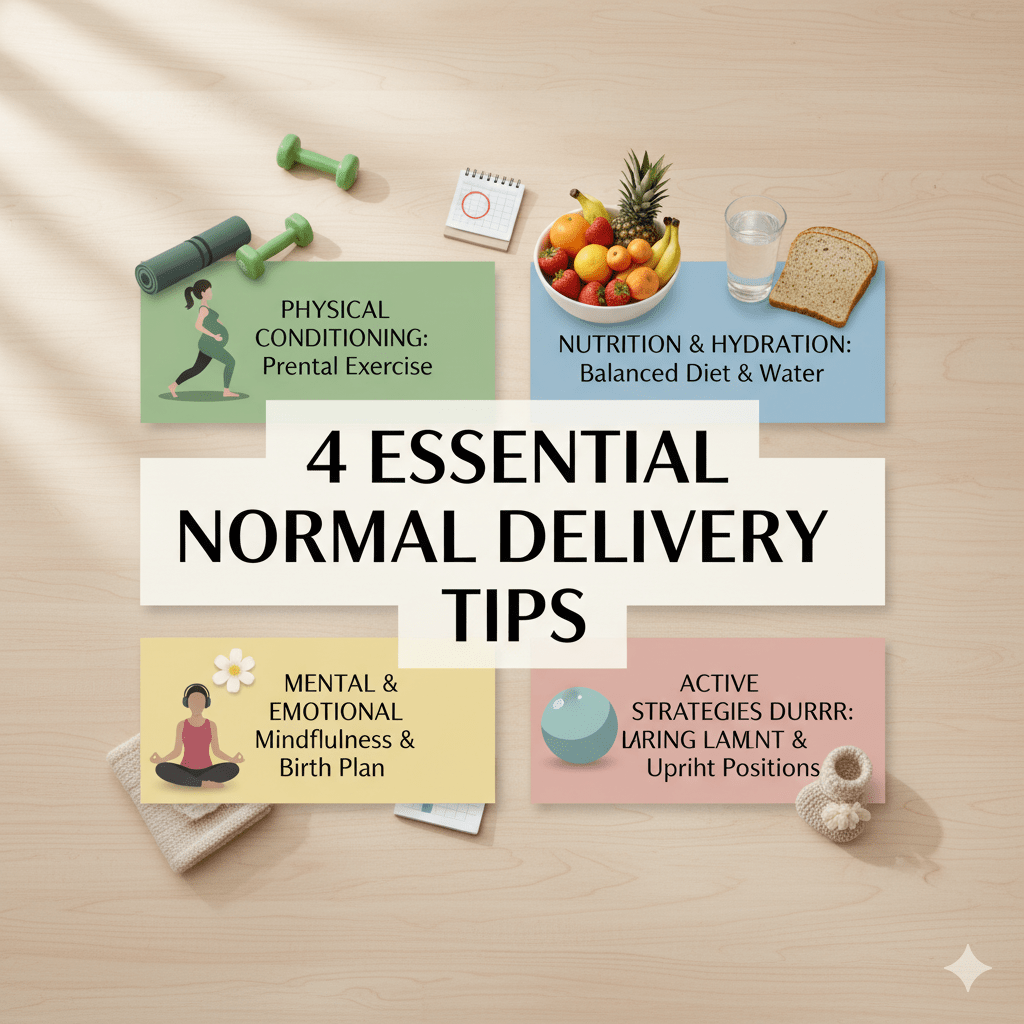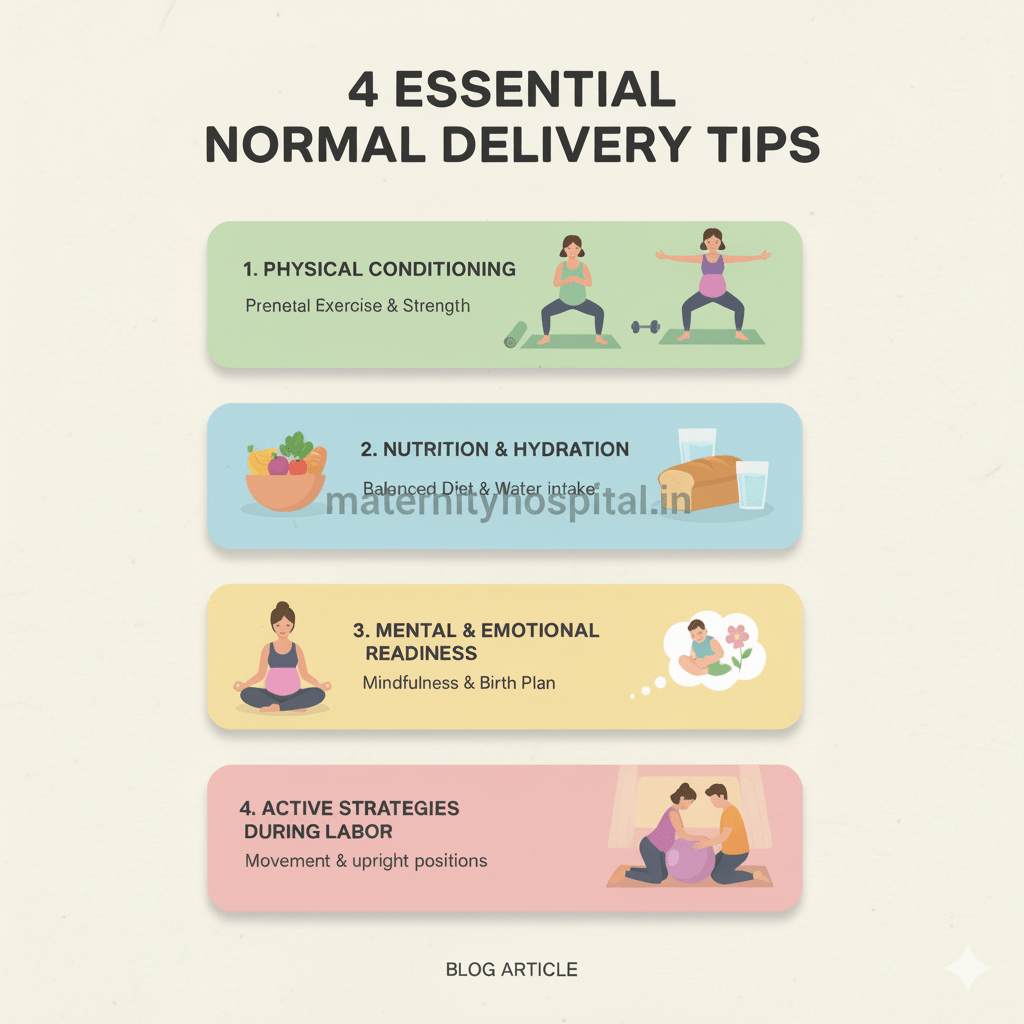
Ditch the Fear: Unlock Your Body’s Power with 4 Essential Normal Delivery Tips
Introduction:Empowering Your Birth Journey – Preparing for a Normal Delivery
The desire for a normal delivery (often referred to as a natural or vaginal birth) is shared by many expectant parents. It is a powerful, transformative experience that, when medically appropriate, can offer significant health benefits for both mother and baby, including faster maternal recovery and potentially better initial immunity for the newborn.
However, achieving a normal delivery is often less about luck and more about informed preparation. It requires a holistic approach, encompassing physical conditioning, nutritional discipline, mental resilience, and the active support of your medical team. It’s crucial to acknowledge that while preparation increases the chances of a normal delivery, the final outcome is ultimately guided by the baby’s and mother’s well-being. The goal is a healthy outcome, regardless of the route.
This comprehensive guide compiles essential, evidence-based normal delivery tips across four key pillars: Physical Conditioning, Nutrition & Hydration, Mental & Emotional Readiness, and Active Labor Strategies. By integrating these practices throughout your pregnancy, you can actively optimize your body and mind for the powerful work of natural birth. Let’s delve into how you can start preparing for this incredible life event today.
Pillar 1 –Physical Conditioning for a Normal Delivery
Preparing your body is the cornerstone of increasing your chances for a normal delivery. Labor is a physically demanding event, and being fit and flexible can make a profound difference in your stamina and comfort.
1. Targeted Exercise: Movement is Medicine
Exercise during pregnancy not only keeps you fit but also improves blood circulation, manages weight gain, and strengthens muscles essential for labor. Always consult your doctor before starting any new routine.
- Walking (The Foundation): A brisk, daily 30-minute walk is non-negotiable. It helps improve pelvic circulation and encourages the baby to settle into the optimal head-down position.
- Swimming: Excellent low-impact exercise that relieves joint pressure and allows you to build stamina without overheating.
- Prenatal Yoga/Pilates: Focuses on poses that open the hips, strengthen the core and back (crucial for supporting the pregnancy and labor), and improve balance. Poses like the Cat-Cow and Butterfly Pose (Baddha Konasana) are particularly beneficial for pelvic mobility.
2. Pelvic Floor and Hip Mobility
A flexible, strong, and relaxed pelvic floor is vital. Tight pelvic muscles can hinder the baby’s descent.
- Squatting: The single best exercise to prepare for labor. Practice deep, supported squats daily (using a counter or chair for balance) to open the pelvis and strengthen the legs.
- Kegel Exercises (Pelvic Floor Exercises): Practice both slow holds (to build strength for pushing) and quick repetitions (for relaxation and control during the pushing phase). Remember to focus equally on relaxation after each contraction.
- Pelvic Tilts/Rocking: Performed on all fours, these movements relieve back pain and help the baby rotate into the best position.
3. Perineal Massage
Starting around 34-36 weeks, perineal massage can help the tissue around the vaginal opening stretch more easily during birth, potentially reducing the risk of tearing or the need for an episiotomy.
- Consistency is Key: Practice for 5-10 minutes daily or every other day.
- Technique: Use a natural, pregnancy-safe oil (like coconut or olive oil) and gentle pressure. Focus on stretching the tissue outwards and downwards.

Pillar 2 –Nutrition and Hydration
Fueling your body correctly provides the necessary energy and building blocks for the intensity of labor, ensuring both mother and baby are sustained throughout the process.
1. The Endurance Diet
Think of your pre-labor diet as preparation for a marathon. You need sustained energy, not quick spikes and crashes.
- Complex Carbohydrates: These are your primary fuel source. Include whole grains, oats, brown rice, sweet potatoes, and whole wheat bread. They provide slow-releasing energy vital for long labors.
- Protein: Essential for tissue repair and strength. Include lean meats, eggs, lentils, beans, and Greek yogurt.
- Fiber: Found in fruits, vegetables, and whole grains, fiber prevents constipation (a common pregnancy discomfort) and supports a healthy gut, which is indirectly linked to uterine health.
- Iron and Folate: Continue taking your prenatal vitamins and consume iron-rich foods (leafy greens, fortified cereals) to maintain healthy red blood cell counts, preparing for potential blood loss during birth.
2. The Power of Hydration
Dehydration is a common cause of premature contractions, fatigue, and headaches during late pregnancy and labor.
- Water: Aim for at least 8-10 glasses of water daily. Staying hydrated keeps amniotic fluid levels healthy and helps the body process nutrients efficiently.
- Electrolytes: During labor, you will sweat profusely. Have natural electrolyte drinks ready, such as coconut water, diluted fruit juices, or sports drinks (in moderation). Avoid excessive caffeine.
3. Specialized Food & Drink
While not universally proven, many midwives recommend certain foods in the final weeks:
- Red Raspberry Leaf Tea (After 32-34 Weeks): Believed to tone the uterine muscle, making contractions more efficient, not necessarily starting labor. (Always consult your provider first.)
- Dates (The Last Month): Studies suggest eating 6 dates per day in the final 4 weeks of pregnancy may lead to better cervical dilation and shorter labor.
Pillar 3 –Mental and Emotional Readiness
The mind-body connection during labor is profound. Fear and anxiety can trigger the release of catecholamines (stress hormones), which can inhibit the release of oxytocin, the key hormone for effective contractions.
1. Education: Replacing Fear with Knowledge
- Childbirth Classes: Attend classes focused on natural coping mechanisms, labor progression, and pain management techniques (breathing, visualization, massage). Knowledge demystifies the process.
- Know Your Birth Plan: Create a flexible birth plan that outlines your preferences for pain relief, positions, and interventions. Sharing this plan with your medical team helps ensure everyone is aligned.
- Choose Your Provider Wisely: Select a doctor or midwife and a birthing location (hospital or birthing center) that has a high rate of and commitment to supporting normal delivery. High intervention rates can influence outcomes.
2. Mastering Relaxation Techniques
- Breathwork: Practice deep, slow abdominal breathing daily. This skill is your single most important tool during labor, helping to oxygenate your muscles and calm your nervous system.
- Visualization and Affirmations: Visualize a smooth, efficient labor and a healthy delivery. Use positive affirmations like, “My body knows how to birth,” or “Each contraction brings my baby closer.”
- Hypnobirthing: This technique focuses on deep relaxation, visualization, and self-hypnosis to manage pain and reduce fear, making labor smoother and more comfortable.
3. Building a Strong Support System
- Identify Your Partner’s Role: Ensure your partner or support person is educated on labor progression, comfort measures (like counter-pressure massage), and your birth preferences. They are your anchor.
- Consider a Doula: A professional labor support person (doula) provides continuous emotional, physical, and informational support, which is clinically proven to reduce the need for pain medication and C-sections.
Pillar 4 –Active Strategies During Labor
Once labor begins, your preparation shifts from long-term conditioning to active coping. Choosing movement over stillness is key to managing contractions and facilitating the baby’s descent.
1. Embrace Mobility: Stay Upright and Moving
Gravity is your friend. Staying upright helps the baby navigate the pelvic curve and increases the efficiency of contractions.
- Rocking and Swaying: Use a birthing ball or lean on your partner while gently rocking your hips.
- The “Four-Point” Position (All Fours): Great for back labor, as it takes pressure off the spine and helps rotate a baby that may be posterior (sunny-side up).
- Slow Dancing: Lean into your partner and sway gently during contractions.
- Walking: Walk the hospital halls during early labor, stopping to lean and breathe through contractions.
2. Utilize Comfort Measures
- Water Therapy: A shower or labor tub can be incredibly effective for pain relief. The buoyancy and warmth help relax the muscles and soften the intensity of contractions.
- Counter Pressure: Have your support person apply deep, steady pressure to your lower back or hips during contractions, especially if you are experiencing back labor.
- Vocalization: Don’t stifle the noise! Low, deep moaning or vocalizing can help keep your pelvic floor relaxed and channel energy positively.
3. Optimal Pushing Positions
When it’s time to push, lying flat on your back is often the least effective position, as it compresses the tailbone.
- Squatting (Assisted): Widely considered the most effective position for opening the pelvis. Use a squat bar, a partner, or a birthing stool for support.
- Side-Lying: Allows for relaxation between contractions and prevents compression of major blood vessels.
- Hands and Knees: Excellent if the baby needs to rotate slightly during pushing.
FAQsAbout Normal Delivery Tips
Here are answers to frequently asked questions about normal delivery tips:
- Is normal delivery always possible?
No. While preparation significantly increases the chances, sometimes medical necessities (placenta previa, fetal distress, preeclampsia, or a poorly positioned baby) require interventions like a C-section for the safest outcome. The ultimate goal is a healthy mother and baby.
- What is the best exercise for normal delivery?
Daily squatting (supported) is arguably the single best exercise, as it directly strengthens the legs and opens the pelvis, mimicking a common birthing position. Daily walking and prenatal yoga for hip mobility are also highly recommended.
- When should I start preparing for normal delivery?
Start as soon as you get a positive pregnancy test, or ideally, during the preconception phase! Nutritional and fitness preparation should begin immediately. Mental preparation and perineal massage usually begin in the second and third trimesters, respectively.
- How does diet affect the ease of labor?
A diet rich in complex carbohydrates and lean protein provides the sustained energy (stamina) needed to endure long labors. Adequate hydration prevents dehydration, which can cause inefficient contractions.
- Can stress prevent normal delivery?
High levels of stress, fear, and anxiety can lead to the overproduction of adrenaline, which is known to inhibit oxytocin release—the hormone that drives labor. Techniques like deep breathing and visualization are essential for keeping the body relaxed and allowing labor to progress naturally.
- What are the best positions to try during labor?
Any position that is upright and mobile is usually best: walking, swaying, standing, rocking on a birth ball, or leaning on your partner. For pushing, squatting, side-lying, and hands-and-knees are generally more effective than lying flat on the back.
- How important is perineal massage?
Perineal massage, starting late in the third trimester, is scientifically shown to help the perineal tissues stretch and may reduce the risk of a severe tear or the need for an episiotomy, particularly for first-time mothers.
Conclusionand Official External Link
Conclusion: Confidence in Your Body’s Strength
Preparing for a normal delivery is a profound act of self-care and empowerment. By diligently following these normal delivery tips—by conditioning your body, fueling it with optimal nutrition, training your mind for calm, and planning to move actively during labor—you are taking charge of your birth experience.
Remember that birth is not a performance; it is a natural process guided by your body’s innate wisdom. Cultivate confidence in your strength, trust your instincts, and surround yourself with a support system that respects your choices. Regardless of the turns your journey may take, know that you have done everything possible to prepare for a powerful, healthy birth and the joyous meeting of your child.
Official External Link Placeholder
For evidence-based guidelines on prenatal care and healthy labor practices, always refer to reputable health organizations.
- Learn more about labor and birth care from the World Health Organization (WHO) at: [Link to WHO Guidelines on Intrapartum Care – e.g.,
https://www.who.int/publications/i/item/9789241550215]










